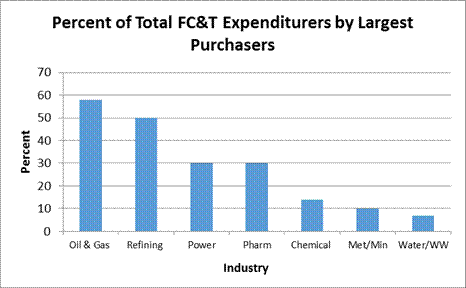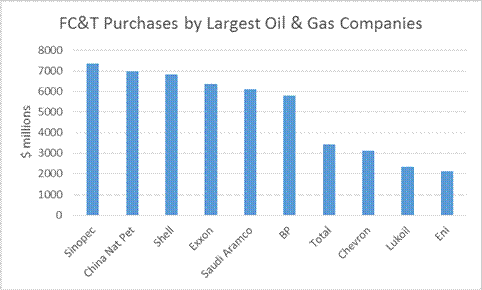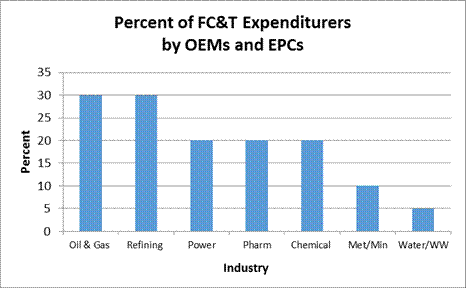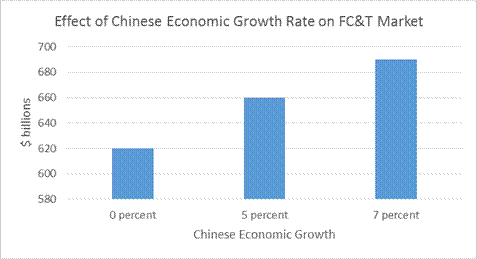
OIL/GAS/SHALE/REFINING
E-Alert
September 15, 2015
McIlvaine Company
This alert is being
issued twice per month for suppliers in flow control and treatment who are
coordinating market research with targeted pursuit of the larger and longer term
orders.
PROJECTS
The following projects each will result in millions of dollars of orders for
flow control and treatment products. Each project has been rated. The
opportunity size is rated from 1-10 with 1 being small and 10 being very large.
The timing for flow and treatment orders has been provided by year e.g., T 16 =
timing of order is 2016.
|
Project Title |
Application
Location |
Opportunity Size/Order Date |
|
Egypt plans $300 Million Refinery Expansion in
Gasoline using UOP Technology |
Refinery
Egypt |
06
T16 |
|
Aquatech awarded Contract to Supply Thermal
Desalination System for Orpic's Sohar Refinery |
Refinery
Oman |
03
T15 |
|
Amec Foster Wheeler to work on Vietnam’s Dung
Quat Refinery Expansion |
Refinery
Vietnam |
07
T16 |
|
Mega-project Expansion of Petroperu’s Talara
Refinery |
Refinery
Peru |
09
T15 |
|
New $161 Million South African Crude Blending
Terminal to Start-up in 2017 |
Oil and gas
South Africa
|
01
T15 |
|
Jacobs receives EPCM Contract for Expansion of
ExxonMobil’s Beaumont, TX Refinery |
Refinery
Texas |
04
T165 |
|
Technip, EGPC and ASORC Agreement for the Assiut
Refinery |
Refinery
Assiut |
06
T16 |
|
KNPC awards Tecnicas Reunidas an Engineering
Contract for Al/Zour Refinery |
Refinery
Middle East |
09
T17 |
|
CB&I awarded Equipment for Afipsky Oil Refinery
in Russia |
Refinery
Russia |
02
T16 |
|
Technip, SACE and Midor Agreement for the
Alexandria Refinery |
Refinery
Egypt |
06
T17 |
|
CB&I awarded $100 Million Contract for Louisiana
Refinery |
Refinery
U.S. |
02
T16 |
|
Kuwait embarks $10 Billion upgrade of 2
Refineries |
Refinery
Kuwait |
08
T17 |
|
Petronas selects Axens Technologies for
Malaysia’s RAPID Project |
Refinery
Malaysia |
07
T16 |
|
Lloyds Energy awards KBR Eurasian FLNG Feed
Contract |
LNG
offshore |
07
T17 |
|
Wood Group awarded FEED Contract from Woodside |
LNG
Australia |
03
T16 |
|
Keppel contracts 3rd Floating
Liquefaction Facility Conversion worth $684
Million |
LNG
Offshore |
07
T16 |
|
Sempra Energy Unit awarded $108 Million Natural
Gas Pipeline Contract in Mexico |
Oil and gas
Mexico |
02
T15 |
Egypt Plans $300 Million Refinery Expansion in Gasoline Using UOP Technology
(06, T 16)
Egypt’s Alexandria National Refining & Petrochemicals Company (ANRPC) will add a
second UOP CCR Platforming process unit, including a modular CCR section, at the
facility to produce high-quality reformate, which is used to produce
high-octane, low-sulfur gasoline. (ANRPC) will use technology and equipment from
Honeywell's UOP as part of a $300 million, multi-year project to expand an
existing gasoline production facility.
Aquatech awarded Contract to Supply Thermal Desalination System for Orpic's
Sohar Refinery Improvement Project in Oman (03, T15)
Aquatech, has been awarded a contract to design and supply a Multiple Effect
Distillation (MED) seawater desalination system for Orpic's Sohar Refinery
Improvement Project in Oman. Aquatech is supplying the system to a Petrofac –
Daelim Joint Venture that has the full EPC contract for the whole refinery
project. Expected to be commissioned in early 2016, the system supplied by
Aquatech will comprise:
Amec Foster Wheeler to Work on Vietnam’s Dung Quat Refinery Expansion - (07,
T16)
Amec Foster Wheeler was awarded a front-end engineering design (FEED) contract
by PetroVietnam for their Dung Quat oil refinery expansion in Quang Ngai
Province, Vietnam officials announced on August 28. The contract is part of the
$1.8 billion expansion and upgrading plan, The two-year contract includes the
optimization of the refinery configuration, coordination of licensors, and the
design for new units as well as the revamp of existing units.
Mega-project expansion of Petroperu’s Talara Refinery - (O9, T15)
Nine new major process units will be installed. Only 5 percent of the present
refinery equipment will be reused, and the existing crude distillation unit will
be the only original unit remaining after the revamp. PMRT involves an
investment of $3.5 billion over five years. The contracts for front end
engineering and design (FEED) and engineering, procurement and construction
(EPC) were awarded to Tecnicas Reunidas as a lump-sum, turnkey contract.
Petroperu has signed a contract with the PMC Talara consortium — members include
Inelectra Argentina SA, Idom Engineering and Consulting SA, and Nippon Koei Co.
Ltd. — to oversee FEED/EPC services.
Existing units to be modernized are:
The new process units under construction are:
Some orders already placed include pumps
Petroleos del Peru SA (Petroperu), through a contractor, has let a contract to
Flowserve Corp., Irving, TX, for the supply of pumping systems.
New $161 Million South African Crude Blending Terminal to Start-up in 2017 -
(O1, T15)
Construction of the 2 billion rand ($161 million) fuel blending farm will begin
in 2017. OiltankingMogs is a joint venture firm developing the terminal. The
terminal is able to fill a VLCC tanker within 48 hours when fully operational.
Jacobs Receives EPCM Contract for Expansion of ExxonMobil’s Beaumont TX Refinery
(O4, T16)
ExxonMobil will add flexibility to process light crudes at its Beaumont
refinery, increasing production capacity by approximately 20,000 barrels per day
Jacobs Engineering Group Inc. will provide engineering, procurement and
construction management (EPCM) services. The project aims to expand crude oil
throughput at ExxonMobil’s Beaumont refinery, increase production in the jet
fuel unit, and optimize energy usage by enabling the crude unit to run different
crude slates.
Technip, EGPC and ASORC Agreement for the Assiut Refinery - (O6, T16)
Technip Italy has an agreement with Egyptian General Petroleum Corporation
(EGPC) and Assiut Oil Refining Company (ASORC) for the modernization project of
the Assiut refinery Upper Egypt designed to refine the “bottom of the barrel”.
The investment has an estimated total value of US$1.5 billion, and aims at
maximizing diesel production. It will introduce the most modern refinery
technologies in Upper Egypt and satisfies the growing local demand for petroleum
products. Technip will now start activities for the project, and will take
responsibility for the EPC phase of the project.
KNPC Awards Técnicas Reunidas an Engineering Contract for Al-Zour Refinery -
(O9, T17)
Técnicas Reunidas has been selected by KNPC to execute the processing units
project for the new refinery of Al-Zour, which will be the largest refinery in
the Middle East.
The contract has been awarded to the international Joint Venture leaded by
Técnicas Reunidas (Spain), Sinopec Engineering Group (China), Hanwha Engineering
and Construction (South Korea) for an approximate value of $4.1 billion and a
duration of 45 months. The project will be developed at Técnicas Reunidas
offices in Madrid.
The new refinery, which means an overall investment of $13 billion aims to
produce and supply ultra-low sulphur petroleum by-products to meet both the
needs of the domestic market and international demand.
The scope of the contract of TR includes the engineering, supply, construction
and commissioning of the following refining units:
CB&I awarded Equipment for Afipsky Oil Refinery in Russia ( 02, T16)
CB&I has been awarded a contract in excess of $90 million by NefteGazIndustriya,
LLC, through project developer MAVEG Industrieausruestungen GmbH, for the
Afipsky Oil Refinery. The scope of work includes detailed engineering,
procurement, fabrication and supply of a steam methane reformer for a
large-scale hydrogen plant, hydrocracking heaters and Breech-Lock®
exchangers. CB&I previously announced two awards on the project—the technology
license and FEED contract and detailed engineering and procurement services for
multiple process units.
Technip, SACE and Midor Agreement for the Alexandria Refinery
( O 6, T17)
Technip Italy S.p.A. and SACE are in agreement with Midor (Middle East Oil
Refinery) for a project to modernize and expand the MIDOR refinery near
Alexandria, Egypt. The investment has an estimated total value of US$1.4 billion
and aims at improving the production quality of the plant, considered the most
advanced of the African continent, by increasing its refining capacity from
100,000 to 160,000 barrels of crude oil per day. Technip will take
responsibility for the EPC phase of the project.
CB&I awarded $100 Million Contract for Louisiana Refinery ( 02, T16)
CB&I announced on July 23 it has been awarded a contract valued in excess of
$100 million for a Tier 3 clean fuels project. The scope of work at the refinery
in Louisiana includes detailed engineering, procurement, module fabrication and
site construction of a naptha hydrotreater and a revamp of an existing gasoline
selective hydrotreater, which uses CB&I's CDHydro®/CDHDS®
technology.
Kuwait embarks on $10 Billion Upgrade of 2 Refineries ( O8, T17)
Kuwait is modernizing its two largest refineries with a 4 billion-dinar ($13
billion) project to produce cleaner burning fuels. The plan envisions curbing
the production of high-sulfur fuel oil at the Mina Al- Ahmadi and Mina Abdullah
refineries, while adding about 20 major units at Mina Abdullah and 17 at the
Al-Ahmadi refineries. Oil-dependent Kuwait plans to invest about $114 billion in
more than 500 projects over the next five years. Kuwait National Petroleum Co.
is the country’s sole refiner and a unit of state-owned Kuwait Petroleum Corp.
Petronas Selects Axens Technologies for Malaysia’s RAPID Project - (O 7, T16)
Petroliam Nasional Berhad (PETRONAS), has selected Axens as a technology
provider for PETRONAS’ Refinery and Petrochemicals Integrated Development
(RAPID) project located in Pengerang, Johor, Malaysia. RAPID is part of
PETRONAS’ Pengerang Integrated Complex (PIC) development, which includes six
major associated facilities namely the Pengerang Co-generation Plant,
Re-gasification Terminal 2, Air Separation Unit, Raw Water Supply Project,
Liquid Bulk Terminal as well as central and shared utilities and facilities.
RAPID is estimated to cost US$16 billion while the associated facilities will
involve an investment of about US$11 billion. PIC is poised for its refinery
start-up by early 2019.
Axens was initially selected in October 2010 for a Detailed Feasibility Study.
The following technologies from Axens was selected for the RAPID project:
Lloyds Energy awards KBR Eurasian FLNG FEED Contract - (O7, T 17)
KBR Inc. has been awarded a near-shore floating LNG Front End Engineering Design
(FEED) contract by Lloyds Energy Ltd. Under this contract, KBR will provide
integrated topsides and hull engineering design services for a nominal 2.5
million TPA floating natural gas liquefaction plant (FLNG). Start-up of the
project facilities is expected to take place in 2019.
Wood Group awarded FEED Contract from Woodside - (03, T 16)
Wood Group has secured a new contract to carry out front-end engineering and
design (FEED) for the Woodside operated proposed Browse Floating Liquefied
Natural Gas (FLNG) Development, offshore Western Australia. Wood Group Kenny
(WGK) will perform all design engineering for the insulated production flowline
system required for the asset’s offshore gas-condensate fields — Brecknock,
Calliance and Torosac — located 300km from the Kimberly coast. The 12 month
contract, which is valued at US$6 million and effective immediately, will be
delivered from WGK’s Perth office.
Keppel contracts 3rd Floating Liquefaction Facility Conversion Worth $684
Million - (O7, T16)
Keppel Shipyard Limited (Keppel Shipyard), a wholly-owned subsidiary of Keppel
Offshore & Marine Ltd (Keppel O&M), has signed a contract worth approximately
US$684 million with Golar Gandria N.V., a subsidiary of Golar LNG Limited (Golar
LNG), to perform the conversion of a Moss type Liquefied Natural Gas (LNG)
carrier, the GANDRIA, into a Golar Floating Liquefaction (GoFLNG) facility.
Keppel Shipyard will once again engage Black & Veatch to provide design,
procurement and commissioning support services for the topsides, as well as the
liquefaction process utilizing its established PRICO® technology. The
GANDRIA is a 126,000 cubic meter Moss LNG carrier.
The PRICO® process uses a single-mixed refrigerant loop for natural
gas liquefaction. The process provides several key advantages, including:
a simplified refrigeration system that requires minimal equipment and a
compact process that makes it ideal for offshore liquefaction, low capital and
operating expenditure
Sempra Energy Unit awarded $108 Million Natural Gas Pipeline Contract in Mexico
- (02, T15)
Sempra Energy subsidiary Gasoducto de Aguaprieta S. de R. L. de C.V., has been
awarded a natural gas transportation contract in Chihuahua by the Comisión
Federal de Electricidad (CFE).
The project will comprise a header facility with a capacity of 3 billion cubic
feet per day (Bcfd) of natural gas and an approximately 14-mile pipeline with a
capacity of 1,135 million cubic feet per day (Mcfd) of natural gas. The pipeline
will provide natural gas to the Norte III Combined Cycle Power Generation Plant
and will interconnect with Gasoductos de Chihuahua, Tarahumara and
Samalayuca-Sásabe pipelines.
The estimated $108 million project is expected to begin operations during the
first quarter 2017. The project is contracted by CFE under a 25-year capacity
contract denominated in U.S. dollars.
These projects are covered in more detail and are integrated in a database which
is part of Oil, Gas, Shale Refining. This semi-monthly report is available as
part of this service or as a
stand-alone subscription.
ANALYSIS
The 10 largest oil and gas companies purchase nearly 60 percent of the flow
control and treatment products (FC&T) for this industry segment.
The 10 largest purchasers account for nearly 60 percent of all flow control and
treatment products purchased for drilling, extraction and treatment. The 12
largest refiners account for 50 percent of refining flow control and treatment
purchases. This concentration is higher than in other industries.

Two Chinese companies are the largest producers in oil and gas. Sinopec has
revenues of over $450 billion/yr.

Seventy-one OEM/EPCs spend $90 billion for flow control. This is an average of
$1.2 billion per company. Eight OEM/EPC companies supplying refinery systems
account for FTC purchases for $20 billion.
The greatest concentration is in the refining industry where just 8 OEM/EPCs
account for 30 percent of the FCT purchased.

The largest oil and gas contractors are:
1.
Bechtel (USA)
2.
Technip (France)
3.
Aker Solutions (Norway)
4.
Chiyoda Corporation (Japan)
5.
SNC-Lavalin Group (Canada)
6.
J. Ray McDermott (USA)
7.
JGC Corporation (Japan)
8.
Hyundai Heavy Industries (South Korea)
9.
Foster Wheeler (USA)
10.
Daelim Industrial Company (South Korea)
Impact of Oil Price and Chinese Economic Downturns on the Oil and Gas Flow
Treatment and Control Market
The market for flow control and treatment is impacted by many different factors.
Some of these factors are constantly changing. Two of the biggest changes in the
last month have been the economic slowdown in China and the lower prices for oil
and gas.
FCT sales in 2015 will be $600 billion of which China will account for 17
percent. If Chinese economic growth continues at 7 percent over the next four
years, there will be an expansion of the total FTC market by $120 billion. Under
a zero annual economic growth in China the world FTC market would only grow by
$50 billion/yr by 2019. This takes into account not only the lower purchases in
China but reduced purchases by suppliers to China.

It now looks as if the economic growth for China in 2016 will be less than the
anticipated 7 percent. Predictions range to as low as 2 percent. This could be
followed by a return to 7 percent growth in succeeding years including 2019.
However, the political and financial management of the economy is facing a
confidence crisis which it must weather if it is to resume its previous growth
levels. There are also questions about the reliability of some of the government
statistics which are used to assess growth. It is therefore necessary to look
beyond the easily available statistics and to continue to analyze the
fundamentals. Even though the stock market has dropped dramatically in the third
quarter of 2015 it still remains at high levels compared to previous years.
Consumer demand is high and with reductions in interest rates, industrial
expansion will be encouraged.
The drop in oil prices to under $40/barrel late in the third quarter 2015 has
immediate impacts on the flow control market. Drilling activity has been
reduced. A number of large projects have been delayed or canceled. However, the
overall impact on the market is softened by the fact that the majority of FC&T
are sold for applications unaffected by oil prices.
The FC&T market will grow by 16 percent from 2015 to 2019 at oil prices of
$80/barrel during the period. At $40/barrel, the growth will only be 9 percent.

The impact of future oil prices on the market can be best predicted by
estimating the impact on the individual segments.
Oil and gas can be divided into two segments. The aftermarket and routine
purchases for small projects represent two-thirds of the total or 10 percent of
the present total market. The longer term large project revenues represent only
1/3. If the price of oil were to continue to remain at $40/barrel through 2019,
revenues in this segment would shrink over the period.
The chart shows percentages of the present 2015 market for the year 2019. At
$40/barrel oil the long range product revenue from the oil and gas large project
segment would shrink by 60 percent from 5 percent of the current market in 2015
to an amount in 2019 which is equivalent to 2 percent of the 2015 market. On the
other hand, the oil and gas aftermarket and market for small projects would grow
slightly during the four year period. In fact, the market for pipeline products
will be positively impacted as low cost oil and gas needs to be moved to more
places.

McIlvaine will continue to assess the likely changes in oil prices based on the
following factors:
·
The breakeven cost for a new well
o
Hydraulic fracturing breakeven point is $30 to $50/barrel equivalent based on
improved management practices and the extraction of more product from existing
wells.
o
Oil and tar sands projects break even at $65/barrel.
o
Subsea is more expensive.
·
New technology developments
o
Bechtel experience with coal seam gas to LNG in Australia indicates lower break
even costs than subsea extraction.
o
China coal to syngas and chemicals could be an alternative which is more than
competitive at $40 oil. McIlvaine has recommended marrying the two stage (HCl/SO2)
scrubbing along with conventional hydrochloric acid leaching to extract rare
earths and generate by product revenue.
·
Demand
o
The slowdown in China could impact demand as could economic problems in Greece
and other countries.
o
Demand is a function of industrial activity. There is little equipment needed to
extract Saudi oil. On the other hand, over 2,000 companies rely on the Alberta
oil sands market for their revenues. The greater the industrial activity the
greater the oil demand.
·
Supply
o
Saudi Arabia could choose to restrict production. In many ways the situation is
analogous to the gold in Ft. Knox. You could sell it at any price and generate
positive cash flow. However, it is a precious and finite resource which is
important to future generations.
o
Market driven companies will typically be reactive rather than proactive and
will only increase drilling after oil prices rise to a level to make drilling
profitable.
·
Political developments
o
Lifting the Iran embargo on oil exports.
o
Russian activities in the Ukraine and elsewhere.
o
Chinese efforts to manage the economy.
o
Uncertainties in North Korea, Greece and Venezuela.
·
Regulatory initiatives
o
Export restrictions.
o
Climate change regulations.
o
Pollution control requirements for hydraulic fracturing.
·
Traumatic events
o
Major oil spills.
o
Large meteorite impact, earthquake or major volcano eruption.
Some of these developments are more predictable than others. The low oil prices
lead to lower extraction activity which eventually leads to shortages and higher
prices. On the other hand, wars, oil spills and earthquakes cannot be easily
predicted. As a result, there will be the need for continuous changes in the
forecasts to take into account the surprises.
The
Oil/Gas/Shale/Refining E Alert is issued twice per month to registered
subscribers. It is not to be resent to others. Each subscriber must be
registered. The first subscription is $950/yr and additional subscribers are $
90/yr. The newsletter is free for those who subscribe to
N049 Oil, Gas, Shale and Refining Markets and Projects.
There is a 30% discount for those building an Opportunity Creation package with
one or more of the market reports and one or more of the E Alerts.
